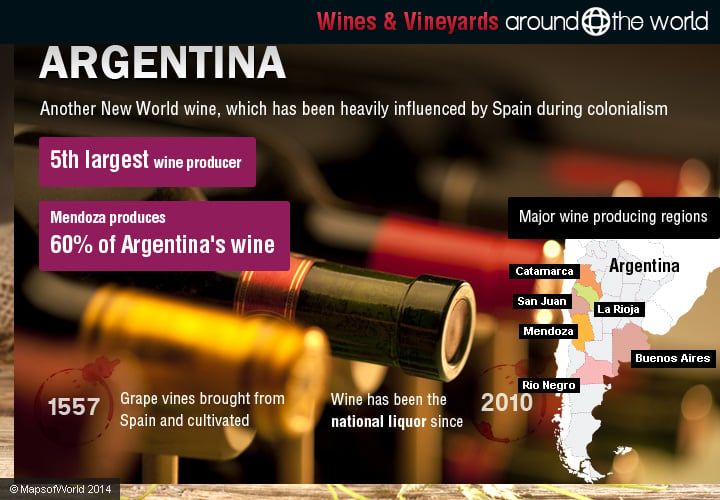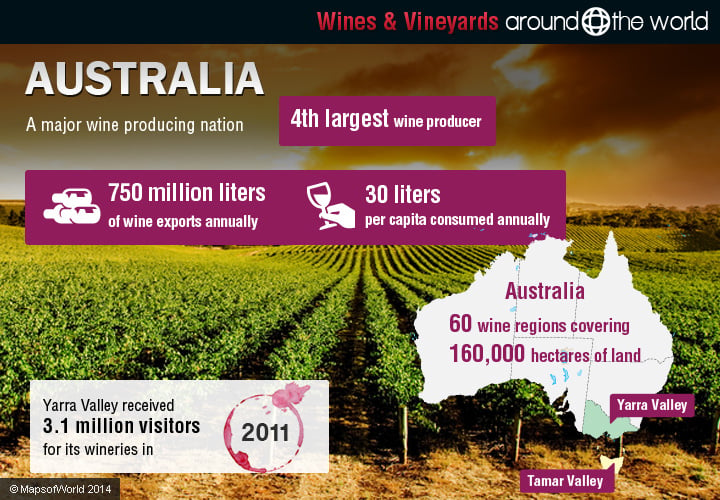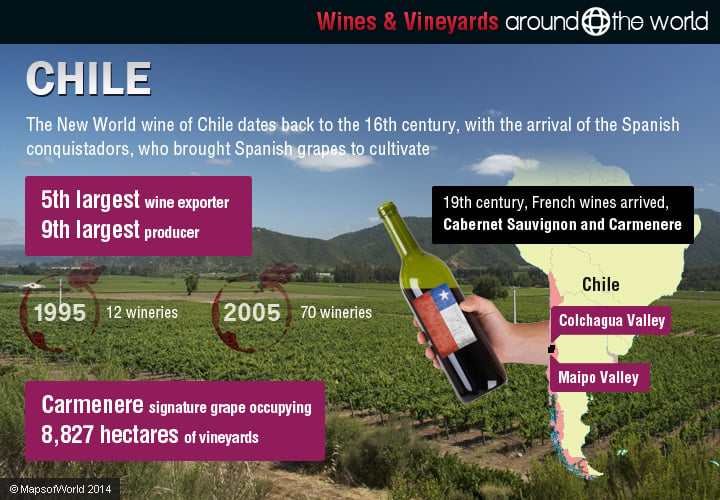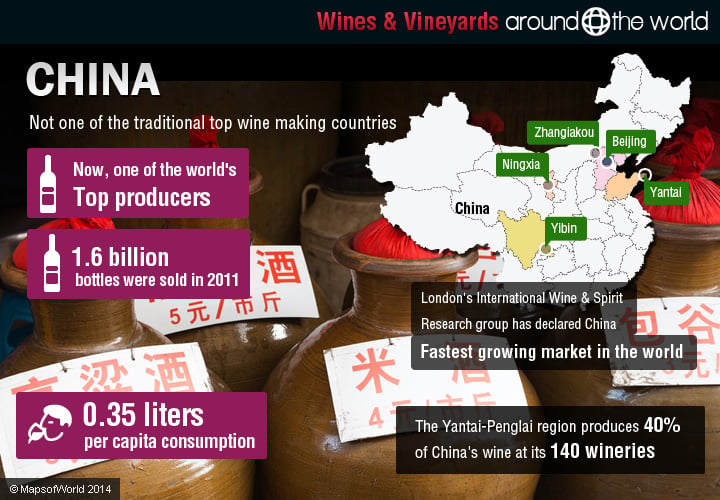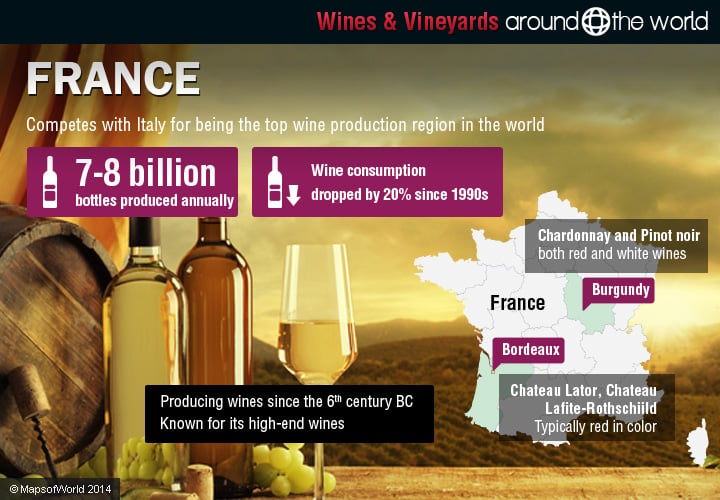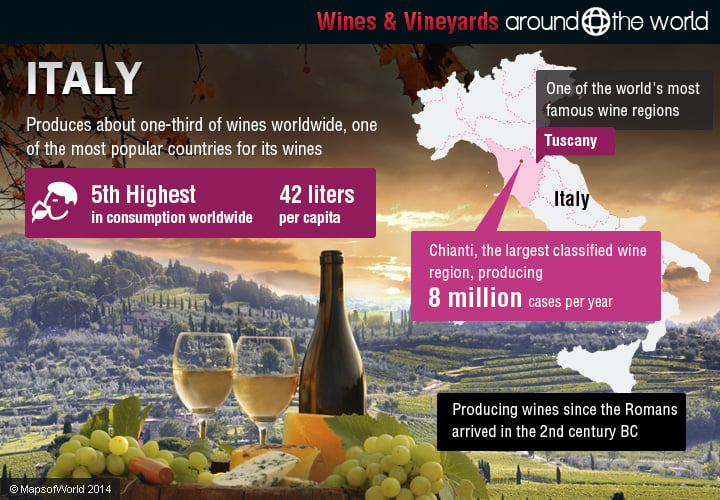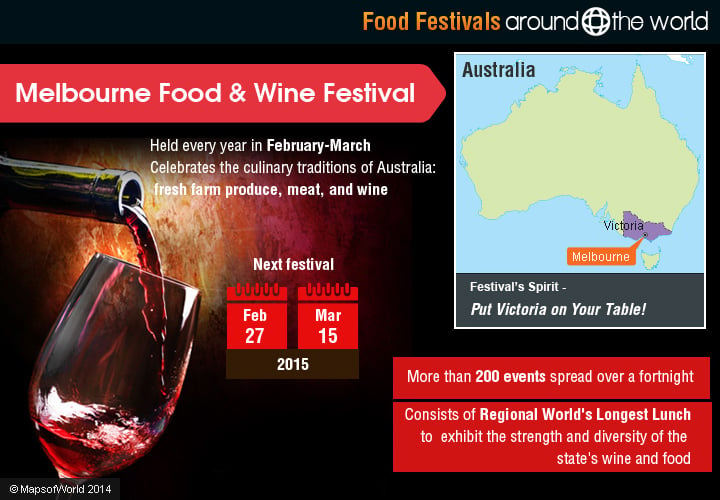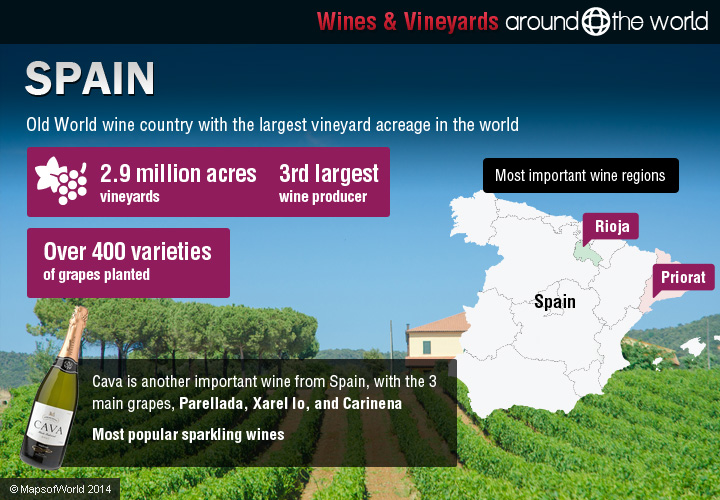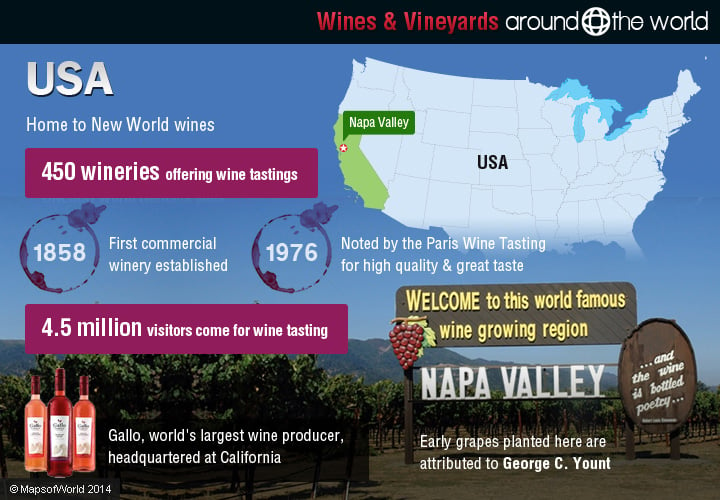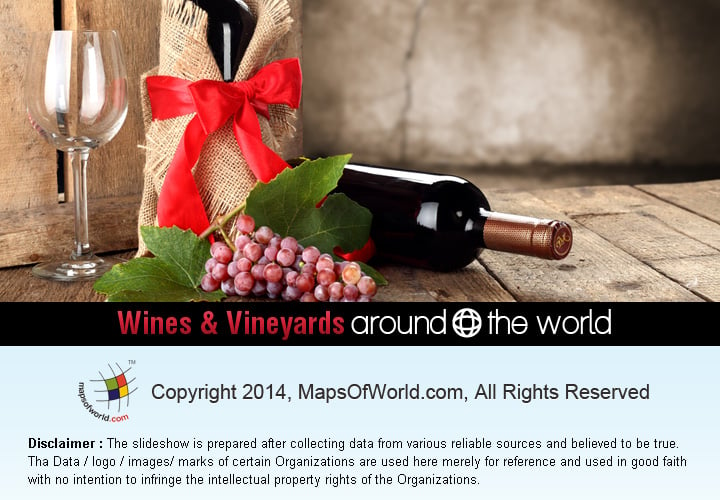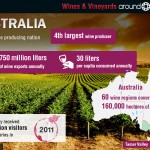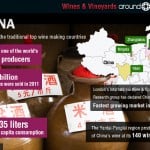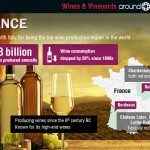Wines and Vineyards Around the World
Introduction
Some of the world’s major producers of wine, include, France, Italy, Spain, the United States, and China. Though Europe and the Middle East are the traditional wine growing areas, explorers brought vines with them when colonizing the New World, leading to the creation of New World wines, which have been influenced by Old World wines, but often take on a life of their own. New World wine producing regions, include, South Africa, Australia and New Zealand, the United States, Argentina, and Chile. Regions with fertile lands, high altitudes, and Mediterranean climates were most beneficial to vineyard attempts and the wine production began to take hold of these regions. Wine consumption has enjoyed an increase in popularity in many parts of the world in recent decades. According to the International Organization of Vine and Wine, wine production increased in 2013 while consumption stabilized (stats here: (http://www.oiv.int/oiv/info/enpoint2013?lang=en). Wine has become an important part of culture in much of the world, as a religious sacrament, a simple accompaniment to dinner, or a sophisticated drink loved by connoisseurs everywhere.
France
France competes with Italy for the top wine production region in the world, producing 7-8 billion bottles of wine annually, though it has lowered its production in recent years. Since 2007, the production of wine has been reduced by 11%. Even domestic wine consumption has dropped by 20% since the 1990s. France has been producing wines since the 6th century BC, and as such, France is known for its high-end wines. Primary grapes used in French wines include Cabernet Sauvignon, Chardonnay, Pinot Noir, Syrah, Merlot, and Grenache.
Two of the most important wine regions of France are Bordeaux and Burgundy. Bordeaux, on the Atlantic coast, is home to vineyards such as St. Emilion, Graves, and Medoc, which export wines around the world. Famous wines from Bordeaux are typically red, like Chateau Latour, Chateau Lafite-Rothschild, and Chateau Cheval Blanc, among many others. In eastern France, Burgundy, produces both white and red wines, especially Chardonnay and Pinot noir. Champagne is also in eastern France, and is home to the world’s most famous sparkling wine.
Italy (Tuscany)
Italy produces about one-third of the worldwide production of wine, and is by far one of the most popular countries in the world for its wines. Italy also ranks the fifth highest in its consumption worldwide, consuming 42 liters per capita. One of the world’s most famous wine regions for Old World wine is Tuscany. While Tuscany is Italy’s third most planted region after Sicily and Apulia and also its eigth highest producer in volume, it is the most famous wine region in the country by far. Tuscany is home to such varieties as Chianti and Cabernet Sauvignon that has been planted in Tuscany for more than 250 years. Tuscan wineries still typically utilize traditional methods of production, including barefoot and vintage. Wine has been produced in Italy since the Etruscans and Greek inhabited the lands, and when the Romans arrived in the 2nd century BC to plant their own varieties of grapes. Major grapes in Italy include Sangiovese and Trebbiano varieties.
Tuscany primarily produces wines based on the Sangiovese grape, as well as Bordeaux blends. Chianti is a zone in central Tuscany and the largest classified wine region in Tuscany, producing 8 million cases per year. There are two documented categories of Chianti wines: Chianti and Chianti Classico, the latter of which comes from an area between Florence and Siena in the original Chianti region. Since 1996, the mix of Chianti and Chianti Classico is required to include at least 75% Sangiovese grapes a maximum of 10% Canaiolo, and less than 20% of any other tested varieties of red grapes from Tuscany. Since 2006, varieties of white grapes such as Trebbiano and Malvasia have been forbidden in Chianti Classico.
Spain
Spain is an Old World wine country with the largest vineyard acreage in the world. Despite its vast vineyards, spanning 2.9 million acres, Spain has low wine yields falling behind France and Italy to become the third largest wine producer worldwide. Spain’s soils are more dry and less fertile than the other top wine countries, though there are over 400 varieties planted in the country. About 20 grapes, especially Tempranillo, Monastrell, Garnacha, Albarino, Palomino, Airen, and Macabeo are some of the most popular. Cava is another important wine from Spain, with the three main grapes, Parellada, Xarel lo, and Carinena.
Rioja and Priorat are Spain’s most important wine regions, and the DOC (qualified designation of origin) areas of Spain. Rioja’s wine production dates back to at least 1063, and as far back as 873 when the first grapes were planted, and the first legal Rioja wine was in 1102. The wineries age their wines in oak, creating vanilla flavors – a trademark of Rioja wines. Barcelona is an important wine region in Spain, with its Mediterranean climate and 9 wine regions in all of Catalonia. Cava is one of the world’s most popular sparkling wines (after Champagne) and is made near Barcelona.
USA (Napa Valley)
The United States is home to New World wines, but its Napa Valley region in California is one of the world’s most popular and certainly the most popular in the United States. California itself is home to the world’s largest wine producer, Gallo, which is situated in Modesto. Napa County is located in California, north of San Francisco. The official designation of Napa wines is Napa Valley AVA, an American Viticultural Area, though many wines produced in the area are a blend of varieties from other nearby regions. There are over 450 wineries offering wine tastings in Napa Valley.
Early grapes planted in Napa Valley are attributed to George C. Yount. The first commercial winery in Napa Valley was established in 1858 and despite sluggish production and consumption in the 19th and early 20th centuries, the region has risen to become a premier wine tasting destination. In 1976, Napa Valley Chardonnay and Cabernet Sauvignon were noted by the Paris Wine Tasting for their high quality and great tastes of wines, establishing the region as a world-class wine producer. Today, over 4.5 million visitors head to Napa Valley for wine tasting, earning the honor by TripAdvisor’s 2010 Travelers’ Choice Awards of being “The World’s Best Wine and Food Destination.”
Major wines in Napa Valley include Cabernet Sauvignon, Merlot, Cabernet Franc, Pinot Noir, Zinfandel, Chardonnay, and Sauvignon Blanc.
Argentina
Another New World wine that has been gaining popularity is Argentine wine, which has been heavily influenced by Spain during colonialism. In 1557, grape vines were brought from Spain and cultivated in Argentina, and later varieties were brought from France and Italy. For many centuries, Argentina consumed most (up to 90% ) of its wine domestically. Today, Argentina is the fifth largest wine producer worldwide. Wine has been the national liquor since 2010.
Some of Argentina’s major wine producing regions, include, Mendoza, San Juan, La Rioja, as well as Southern Buenos Aires, Rio Negro, and Catamarca. Mendoza produces about 60% of Argentina’s wine, and is a great place for growing wine grapes for its climate and high altitude. Mendoza’s main grape varieties include Cereza, Criolla Grande, and Malbec, as well as Cabernet Sauvignon and Tempranillo. Cereza, Criolla Grande and Chica together make up 30% of vines in Argentina. The Argentine Malbec is one of the country’s claim to fame. About 60% of Argentina’s wines are red.
Australia
Australia is a major wine producing nation, ranking fourth in the world for its 750 million liters of annually exported wine. Within the country, about 530 million liters of wine are consumed, equaling 30 liters per capita. There are 60 wine regions in Australia, covering 160,000 hectares of land, of which major regions include South Australia, the Yarra Valley east of Melbourne, and Tamar Valley, both known for their Pinot Noir and Chardonnay. Yarra Valley received 3.1 million visitors for its wineries in 2011. Major varieties include Shiraz, Pinot Noir, Chardonnay, Merlot, Cabernet Sauvignon, and Riesling. Shiraz, known as Syrah in other countries, is one of Australia’s best known wines, which has quickly gained popularity since the 1990s, tripling its production. Shiraz and Chardonnay make up 44% of Australia’s wine production.
Wine production in Australia began as far back as 1788, brought from South Africa, though the early production failed and was revived later. The first Australian wine were sold in the 1820s.
South Africa
South Africa is a world-class wine producer that has emerged in the past decade as a country with high quality wines, particularly from its Cape Town region as well as Cape Winelands, Stellenbosch, Paarl, Worcester, and Franschhoek. The country is known for its Chenin Blanc cultivation, while Sauvignon Blanc, Chardonnay, Shiraz, Cabernet Sauvignon, and Pinot Noir are other popular types of wine. Apart from the Chenin Blanc, which makes upto 18% of the grapes in South Africa, common grapes include Colombard, Riesling, Palomino, Muscat of Alexandria, and Trebbiano. Pinotage (a hybrid between Pinot noir and Cinsaut) is the second most commonly planted red grape. There are 250,000 vineyard acres in South Africa, about 56% of which are white, and 44% of which are red.
South Africa is best known for its oldest and most famous vineyard, Constantia, near Cape Town which was first opened in 1685. Wine has been produced at the estate since then, though it became popular much later in 1778 under new ownership. Constantia wines were commonly exported to Europe. Groot Constantia and Klein Constantia were its wineries. Production was stopped from the late 19th century until 1986 at Klein Constantia and 2003 at Groot Constantia.
Chile
The New World wine of Chile dates back to the 16th century, with the arrival of the Spanish conquistadors, who brought Spanish grapes to cultivate. In the 19th century, French wines arrived in Chile, including Cabernet Sauvignon and Carmenere. Carmenere is called “the lost varietal of Bordeaux” because in the 19th century, it disappeared from Europe and reappeared in Chile. Today, Carmenere is Chile’s signature grape, occupying 8,827 hectares of vineyards in Chile. The appellation system of Chile is DO, meaning Denomination of Origin.
There are several major wine regions in Chile, especially along the Pacific Coast, which gives the area a climate similar to that of California. One of these regions is the Colchagua Valley, which is situated at 650 feet to 3,110 feet above sea level, and spread over valley and hills, similar to Napa’s geography. Another important wine region in Chile is the Maipo Valley, the most historic region where the Spanish first brought their vines. Maipo is home to Cabernet-based wines.
Wine production has really taken off in recent history, growing from 12 wineries in 1995 to over 70 wineries a decade later in 2005. Chile is the world’s fifth largest wine exporter and the ninth largest producer.
Portugal
Portugal is a major Old World wine country, boasting two UNESCO World Heritage sites for its wine producing regions: Douro Valley Wine Region and Pico Island Wine Region in the Azores Islands. Wine has been produced in Portugal since the Roman Empire, though under Arab rule around the 12th and 13th centuries, wine production was drastically reduced. The Portuguese region of Madeira Island saw the formation of new varieties of wine, including Madeira, Setubal, and Colares.
Grape varieties popular in Portuguese wines, include, White castas Alvarinho, Red castas Touriga Nacional, and White castas Moscatel Galego Branco. The major wine varieties of Portugal, include, Vinho Verde made from immature grapes, Douro and Port wines, Dao, Bairrada, Alentejo, and Colares wine. Port is a sweet dessert wine produced in the city and UNESCO site in the Douro Valley and exported from Porto. Portugal is the seventh largest exporter of wine worldwide.
China
Though (grape) wine has been made in China for over 4,600 years, China is not one of the traditional top wine making countries, nor has it been known for its wine exports. However, China is sometimes seen as the latest frontier for wine production. London’s International Wine & Spirit Research group has declared China the fastest growing market in the world for wine and it is now one of the world’s top producers. There are over 400 wineries in China today, and about 1.6 billion bottles of wine were sold in China in 2011. Per capita consumption of wine in China is about 0.35 liters. The three major wine producers in China are Dynasty, Great Wall, and Changyu Pioneer Wine. Ningxia has connections to French wine producers, and has begun producing internationally acclaimed wines. Other regions of China producing wine are Beijing, Yantai, Zhangjiakou, and Yibin. The Yantai-Penglai region produces 40% of China’s wine at its 140 wineries.
Merlot is difficult to grow in most of China because of its climate and production is still limited, though growing. China has not begun to regulate its wine or wine regions and labels often do not display the vintage date or location of the vineyard. In the last decade, Chinese wineries have begun to produce high-end wines with vintage date on the bottles as the Chinese economy continues to grow.
Read More
- Most Expensive Cheese around the World
- Wines and Vineyards Around the World
- Drinks To Try Around the World
- Dance Forms Around the World
- Christmas Myths and Legends
- How to Say Hello around the World?
- The Dying Art of Hand Writing
- China to do away with one-child policy
- All you need to know about Halloween
- Top 10 Favorite Wines
- Ten Most Relished Foods Around the World
- Tribes Around the World
- Food Festivals Around the World
- Gay Laws Around the World
- Matriarchy Around the World
- Royal Families Around the World



